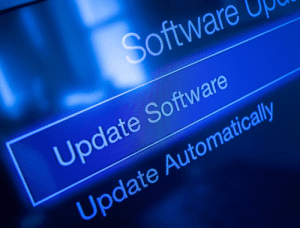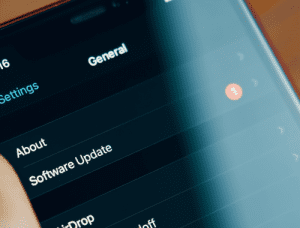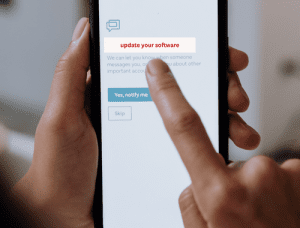Beware of software update scams
Are you getting a notification on your device to update software? If yes, don’t click it; otherwise, all your data will be breached. Yes, you read it right, many software update notifications are just scams, nothing else.
Do you know how these fake software update notifications steal your data? Let me tell you. Usually, Users get the notification to urgently update their software on their device. If they click the link to update their device’s software, they will unknowingly introduce malware into their device. According to a report, there have been about 800,000 cases of cyber security.

These scammers scare the users with fake messages like they urgently need an update. People panic and open the links. These kinds of malware are more dangerous as they access everything on the device. The scammers use logos and icons to make their messages look more authentic. Do you want to know more about software update scam? Yes? Keep reading. Here I’ll explain what a software update scam is and how to avoid it.
Types of software update scams
There are different types of software scams that cybercriminals use to hack others’ device data. These criminals are hazardous as they can impersonate some fully trusted software updates and services like Windows and Google to make users believe that these ads are genuine.
-
Fake windows update
Fake Microsoft messages are a famous way to hack a user’s computer. Through these messages, users can install updates for counterfeit versions of Microsoft Office programs like Microsoft Exchange, etc. The criminals’ main target is access to common language runtime (CLR). CRL manages security, memory, and exception handling. Thus, the Net function is the primary goal of these scammers.
Microsoft has some protection tools like KeePass Password Safe, a free and open-source password manager used for Windows.
-
Fake Android software update
Android phones contain more user options than iOS-based phones. If you see, there are more disadvantages to this than advantages. As users can download and install many software on devices, they can become prone to different attacks and hacks.

-
Fake chrome update
Google Chrome is one of the best and most secure web browsers. So, if users get a notification on it to update the application. if it seems threatening and you clicked it then it can harm your devices and chrome data.
Additionally there is a way to verify whether these updates are authentic or not. You can verify them on different Google channels.
-
Fake Flash player update
Scammers adopt so many tactics. One of these tactics is fake flash updates. Many non-technical users get scammed by these tactics as they don’t have much knowledge.
There can be different ways to trick users, like asking them to update their BIOS version, batch files, and files related to specific programs installed on the computer. Your device will be prone to attacks on the entire network.
What do fake software updates do?
After you have installed a fake system or software update, your device will be prone to ransomware attacks or attacks on the entire network.
Although all attacks are quite different, they can have behavior-monitoring capabilities like sniffing and key logging. With these techniques, scammers can get your personal information like username, password, and credit card number.
How to detect fake software update
You need sophisticated software and AI working together to detect different clickbait tactics or fake software update ads. These scams become difficult to detect if they have social engineering elements.
It becomes quite impossible to detect if these have various layers But you need to worry; There are various detection can solve this problem. It aggregates the data and insights and analyzes them to determine whether they are fake. It checks data points from multiple detection engines and gathers machine-readable information from these landing pages and system pops.
Tips to avoid software update scam
Here are some common software update scams such as
-
Don’t click on the notification.
If a notification pops up on your desktop to update your software, don’t click on it. Because such notifications are just scams. When you click on them, the software starts downloading and installing in your device system, and your device data gets leaked. So ignore such notifications. Don’t tap on them because your device system does not ask you to update any software.

-
Block ad campaign
The most beneficial way to avoid these scams is blocking the ad Campaigns that make users download these updates.
Publishers can’t block these ads because they will lose ad yield. Nowadays, attacks are very common. But few tools makes it quite easy. It contains a code that detects malicious ads and changes them with good ads. These are not prone to human errors and save users from threats.
-
Ignore the software update email notification.
The software updates do indeed come via email. The cyber crooks generate these fake emails and send you software updates that need to be updated, but this software contains links that are malware that can infect your device. So whenever you receive this kind of software update email, don’t click on the link; just ignore it or block this email address to avoid this software update scam.
-
Say no to web banners.
Another software update scam is updating software by clicking on web banners. But you have to know that no web banner can give you instructions on updating the software. So, if you receive notifications from web banners to update software, don’t believe it; otherwise, your data will be stolen.
-
Ignore virus alert
Is your device showing that your device is full of viruses? Or suggesting you click on a pop-up notification to eliminate viruses from the device? Then it’s a red flag for you Because no device sends alerts that your device is virus-infected. So don’t get trapped and ignore such alerts.
-
Skip browser pop-up
While using a browser, your browser may show you a notification, which will be shown directly on your browser. But such a notification contains malware that infects your device when you tap on it. So, never try to click on it and save your device.
Conclusion
Updating software is good because it keeps your system updated, but sometimes, you may receive fake software update notifications. This software scam is common, and thousands of people lose their personal data each year. Scammers send software scams by sending ads, notifications, or download/ play buttons.
After clicking on these links or messages, the users get hacked by believing that they need to update. After clicking on the download option, users give access to these scammers. At this time, users are unaware that they gave access to the hackers, so always try to avoid such ads and notifications to protect your device data. if you get scammed then do report you scam to Cyber crime Police.
For More information Related to Scams you can browse more Posts on Verifyscams.com



